Materials/ Energy
Material Issue Materials
- Targets/Vision
- ● Use of raw materials without waste
Management and Promotion Method of Materials
[Responsible Departments]
- Business divisions
- Manufacturing Planning Center
Coordinating office: Environmental Promotion Department of Manufacturing Planning Center
[Policy/Point of view]
The Group sets forth the preservation of the global environment in the “Group Code of Conduct” and the “Environmental Basic Policy” and strives to save resources and energy and reduce wastes and hazardous substances in each stage of technology development, design, procurement, production, sale, and use of products and services.
[Targets/Vision]
- Raw material input intensity of below fiscal 2023 target (0.089)
- Use of raw materials without waste
[Measures]
- Determine priority issues based on the waste analysis (reduction of loss and defective products) and promote initiatives on the recycling issues
Use of raw materials without waste
The Company’s industrial waste largely consists of rubber and plastics. The Company strives to reduce waste primarily by curbing waste generation at manufacturing sites.
In fiscal 2024, as initiatives to reduce waste, we continued to promote development and new production methods considering the waste reduction from the designing stage. We also worked to reduce defective products and losses while reinforcing the segregation of reusable materials from waste to promote their conversion into valuable resources. Through these efforts, the amount of raw material-related waste decreased by 4.2% year-on-year to 2,352 tons. Raw material input intensity also improved to 0.102 (t/t), 93.6% of fiscal 2023.
Raw material-related wastes, intensity of raw material input (Bando Chemical Industries)
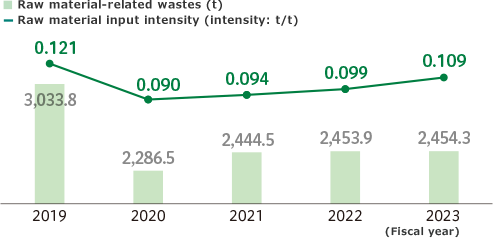
Material Issue Energy
- Targets/Vision
- Reduction of energy consumption
Management and Promotion Method of Energy
[Responsible Departments]
- Manufacturing Planning Center
- Business divisions
Coordinating office: Company-Wide Environment Committee (Secretariat: Environmental Promotion Department of Manufacturing Planning Center)
[Policy/Point of view]
The Group sets forth the preservation of the global environment in the “Group Code of Conduct” and the “Environmental Basic Policy” and strives to save resources and energy and reduce wastes and hazardous substances in each stage of technology development, design, procurement, production, sale, and use of products and services.
[Targets/Vision]
Reduce energy consumption (KL)/Raw material input (t) from the previous year’s level, and decrease the 5-year average reduction rate by 1% or more (consistent with the target of the Energy Conservation Act)
[Measures]
- 1. Shift to energy-saving equipment
- 2. Reduce energy loss (investigate details of loss due to steam leak, implement necessary measures, etc.)
Reduction of energy consumption
Our initiatives to reduce energy consumption include conducting energy saving patrols whereby we check the improvement activities and energy usage in the production processes and give guidance to cut energy waste and engaging external energy management experts to conduct research.
Based on the results, in fiscal 2024, we designated energy loss reduction as a key material issue and carried out re-inspections, repairs and improvement measures for equipment at each plant. As a result, although energy consumption slightly increased to 101.2% of fiscal 2023 due to increased raw material input, intensity improved to 96.6% of fiscal 2023.
Energy consumption per volume of raw material input (Bando Chemical Industries)
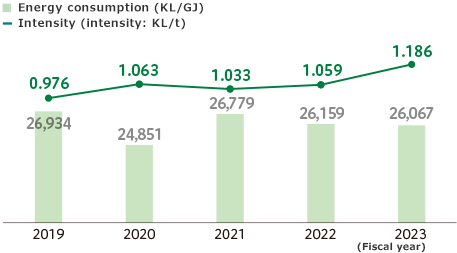
Introduction of renewable energy
We are promoting the introduction and utilization of renewable energy, and since fiscal 2010, we started introducing solar power generation systems gradually. In fiscal 2024, Bando Manufacturing (Thailand) Ltd. installed an additional solar power generation system with a capacity of 1,198kW. This is equivalent to about 11.7% of the total electricity used in the base, and CO2 emissions will be reduced by approximately 828t-CO2 per year. Combined with the 998kW solar power generation system introduced at the plant in fiscal 2021, solar power now accounts for approximately 21.3% of the total electricity used, which is expected to reduce CO2 emissions by about 1,546t-CO2 per year (approximately 10.5% reduction for the entire base). We will continue to actively consider introduction of solar power generation systems.
● Energy production in fiscal 2024
| Business facilities with solar power generation systems | Solar cell capacity (kW) | Annual energy production (thousand kWh) |
|---|---|---|
| Wakayama Plant | 350 | 472.5 |
| Kakogawa Plant | 160 | 166.1 |
| Nankai Plant | 200 | 258.5 |
| Ashikaga Plant | 1,750 | 2,514.0 |
| Bando Manufacturing(Thailand)Ltd. (Production base in Thailand) |
2196 | 2,219.2 |
| Bando (India) Pvt. Ltd. (Production base in India) |
1,000 | 1,377.5 |
| Bando Belt (Tianjin) Co., Ltd. (Production base in China) |
741 | 848.4 |
| Bando Iberica, S.A. (Sales base in Spain) | 18 | 28.6 |
*Electricity generated at Ashikaga Plant (BANDO eco moving Ashikaga solar power facility) is sold to the Tokyo Electric Power Company Group through our group company using the FIT system for renewable energy.
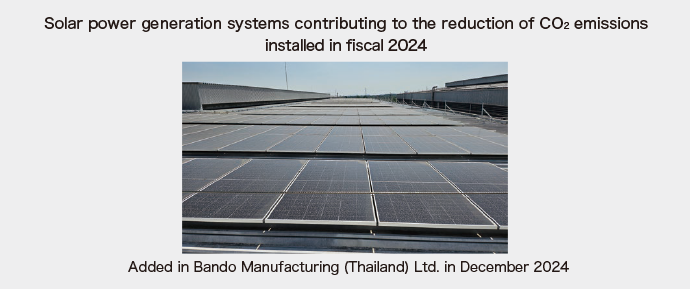
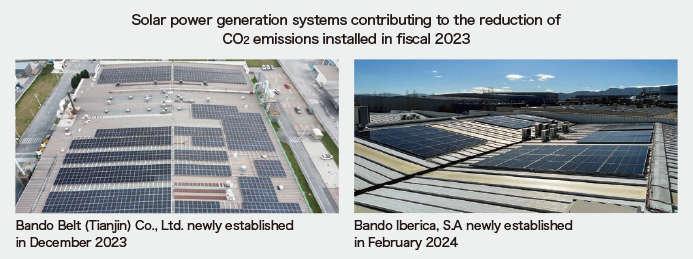
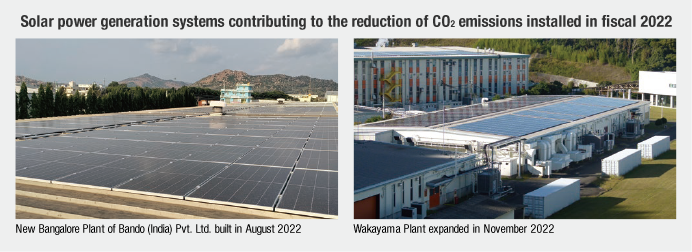
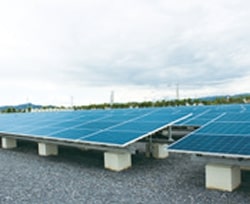
Solar panels at the BANDO eco moving solar power facility
TOPICSApproach to environmentally-friendly office
| As part of our group-wide initiative to switch to LED lighting, in fiscal 2020, we switched the lighting of the office building at Head Office to LED lighting, reducing annual power consumption by 91,110kWh. We also implemented measures such as using recycled water for toilet, dissolving paper waste such as unnecessary documents (recycled as toilet paper) and collecting/recycling cardboard boxes and used paper. In addition, all employees made a united effort to promote eco-office initiatives including the “Cool/Warm Biz campaigns” which maintain the room temperature at 28℃ in summer and 19℃ in winter with employees working in comfortable clothes throughout the year and the movements to automatically turn off the light and let in external light from windows during lunch break and to use stairs instead of elevators. In local community, we participated in a “Social experimentation of common boarding pass,” which encourages to use bus instead of Port Liner to mitigate congestion of Port Liner, by Kobe City in order to avoid the three C’s (closed spaces, crowded places, and close-contact settings) amid the COVID-19 pandemic. | 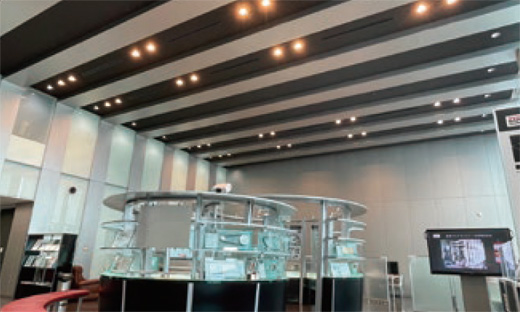 LED lightening of the office building at Head Office |
|---|
TOPICSSwitch to high-efficiency equipment and LED lighting system
At Ashikaga Plant, we employed the Ministry of the Environment’s
ASSET* to switch to a power generator that uses city gas instead of heavy oil and
air conditioning equipment that uses waste hot water from the generator, and also
introduced LED lighting. The subsidy is granted for CO2 emission control measures
subject to the introduction of certified products using leading and low-carbon
technology. We started to work on the concept in 2015 and it took us three years to
evaluate profitability and finalize the plan to apply for the subsidy and finally
complete the plan.
The new power generator provides most of the electricity used by the plant (half in
the summer and two-thirds in the spring, fall and winter). In fiscal 2018, such
equipment replacements and shift to LED lighting reduced CO2 emissions by
1,606.9t-CO2, or over 19.5% of the annual CO2 emissions at Ashikaga Plant.
* ASSET: Advanced technologies promotion Subsidy Scheme with Emission reduction Targets

Improvement of Energy management technology
We have energy management training for energy managers to learn about equipment and design energy saving equipment for manufacturing.






